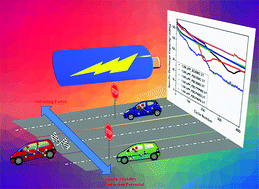Principle in developing novel fluorinated sulfone electrolyte for high voltage lithium-ion batteries†
Abstract
A new class of fluorinated sulfones, β-fluorinated sulfones, were designed and synthesized as electrolyte solvents for high voltage lithium-ion batteries. While the oxidation potential of β-fluorinated sulfones is slightly lower than that of α-fluorinated sulfones, it is still significantly higher than the oxidation potential of regular sulfones, which already possess fairly high anodic stability. However, β-fluorinated sulfones exhibit a significant decrease in reduction potential compared to α-fluorinated sulfones, rendering them more stable towards graphite anodes. Moreover, the reduced lithium solvating power of β-fluorinated sulfones compared to regular sulfones mitigates the transition metal dissolution of cathodes. Taken together, these middle ground properties of β-fluorinated sulfone-based electrolytes enable the very stable long-term cycling of graphite‖LiNi0.6Co0.2Mn0.2O2 full cells. The outstanding performance of β-fluorinated sulfones designed by applying the “golden middle way” paves a new path for the development of an effective electrolyte system.



 Please wait while we load your content...
Please wait while we load your content...